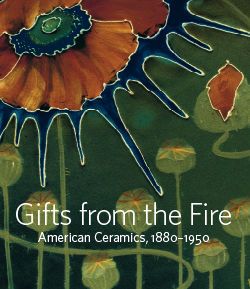Plaque with marsh scene
M. Louise McLaughlin American
Louise McLaughlin was a pioneering figure in the history of American ceramics. Like many women of her time, she began her artistic career as a china painter. One of her earliest innovations was her discover of the barbotine technique in the late 1870s and early 1880s. By the mid-1880s when the vogue for barbotine ware had waned, she turned back to china painting and other artistic endeavors. McLaughlin and others were exceedingly influenced by Japanese design as the decoration on this plaque, which features three white herons landing in a marsh with cattails, sea grasses, iris, and waterlilies. These Japanese subjects, of the kind often represented in Western manuals on Japanese design, show a charming naiveté, exaggerated by the disproportion of scale of the birds and plants, as well as the awkward pose of the descending herons. In an ironic twist, McLaughlin’s mark on the reverse side imitates the celebrated cypher of crossed L’s used on eighteenth-century Sevres porcelain, except that here the letters form a monogram for “Louise” and “Laughlin.” These unlikely cross-cultural references suggest the complicated patterns of thought that then prevailed.
Due to rights restrictions, this image cannot be enlarged, viewed at full screen, or downloaded.


